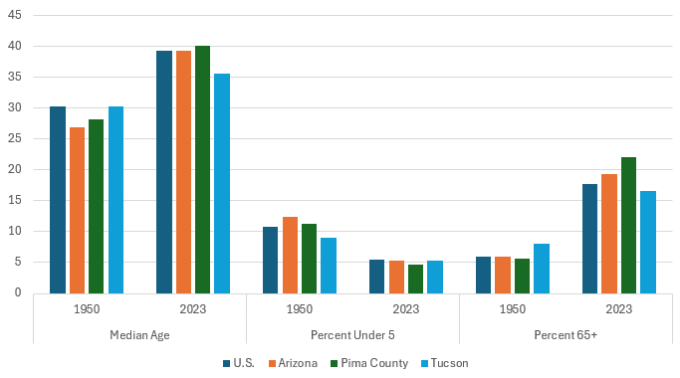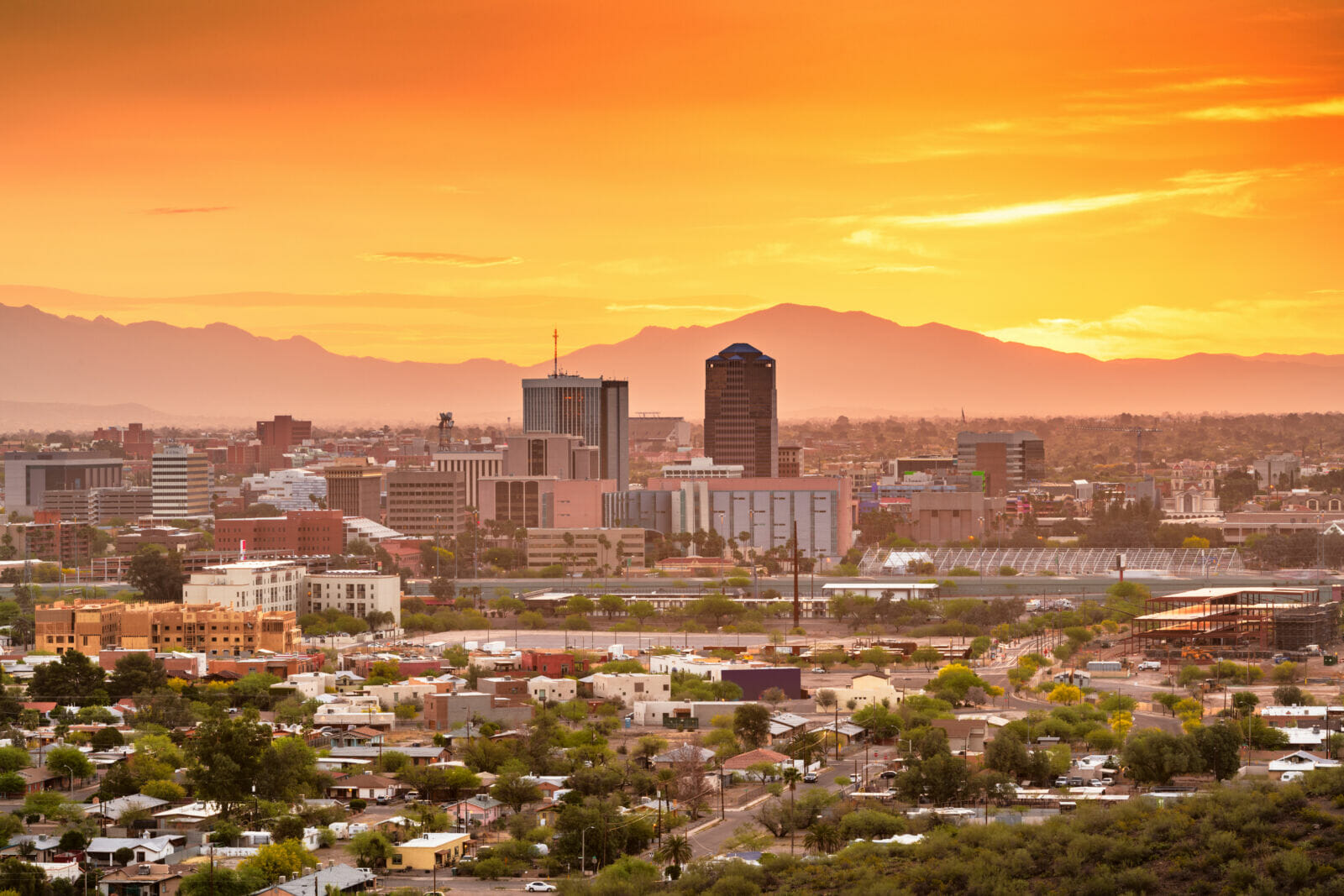The Economic and Business Research Center (EBRC) celebrates its 75th anniversary this year. As we look back over the three-quarters of a century that the Center has been in existence, we thought it would be interesting to take a look at Tucson then and now and how the city has changed in that time. When the Bureau of Business Research (now the Economic and Business Research Center) began in the summer of 1949, Tucson city had less than 50,000 residents, and fewer people lived in Arizona than in Pima County today.
MORE NEWS: Inflation rate hits lowest level since February 2021
This article will compare the Tucson Metropolitan Area (which is Pima County) and the city of Tucson using the 1950 Census of Population through the 2020 Census and the 2023 American Community Survey (ACS) one-year estimates, which are the closest available demographic data within the timeframe of 1949 and 2024. When referencing Tucson in this article, we are referring to the city, not the metropolitan area (which would be the county). Arizona and the U.S. data for these two periods will also be included for a broader perspective and other geographies within the state will be highlighted when noteworthy. Here is a look at what the population and economy of our area looked like then and now.
Population and Growth Over Time
Pima County grew by leaps and bounds in the 1940’s, with the population increasing by 93.9%. The population of the county in 1950 was 141,216. Pima County was the fastest-growing county in the state in 1950 and had the second-largest population, behind Maricopa, which boasted a population of 331,770, with a 78.2% increase over 1940. In contrast, the state of Arizona grew 50.1% during the same period, with a 1950 population of 749,587. (Arizona was the second-fastest growing state in the nation for the 1950 Census, following California.) In 1950, Pima and Maricopa counties totaled 63.1% of Arizona’s population. By 2020, the total of the two counties had moved up to 76.4% of the state’s population.
The city of Tucson had a population gain of 27.1% to 45,454 between 1940 and 1950. The increase was based on a revised 1940 Census population count that removed the population of South Tucson from the Tucson figure. South Tucson was incorporated in 1939 and had been included in the Tucson population up until the 1950 Census. The 1950 Census listed several cities and towns for Pima County. Tucson and South Tucson, with a population of 2,364, were the only incorporated towns; however, there were also a few unincorporated places that may sound vaguely familiar to someone currently living in Tucson. The unincorporated places with 1,000 or more people were Ajo (5,817), Amphitheater (12,664), Pasqua Village-El Rio (5,466), and Wakefield (8,906). Prominent cities and towns in Pima County that were not in existence in 1950 are listed here with their year of incorporation: Oro Valley (1974), Marana (1977), and Sahuarita (1994).
When the Bureau of Business Research was established in 1949, Tucson and the state were poised for growth, and the 1950’s proved this to be true. Arizona has been one of the top-growing states in the nation for many decades. The period of the 1950s was the pinnacle of growth for the state as well as for Tucson. Tucson grew not only in population but also in physical size. The majority of the increase in the Tucson population between 1950 and 1960 was due to annexation since over 78% of the city’s population in 1960 was in recently annexed areas.
Pima County grew faster than the state in the 1940s and 1950s but has not matched the pace since then. Since 1960, the city of Tucson has grown slower than the county or the state. Exhibit 1 provides a look at how Tucson, Pima County, the state, and the nation have grown over the decades that the EBRC has been in existence.
Exhibit 1: Growth Over the Decades
Demographic Characteristics
In 1950, the median age in Pima County was 28.2 years, older than the state at 26.8 years but younger than the nation at 30.2 years. The median age for Tucson city was even older yet, at 30.3 years. The percentage of people 65 years and older was 5.9% nationally and in Arizona. Pima County was a bit lower, at 5.6%, while Tucson had the highest percentage at 8.1%.
Current trends show the share of older people in Pima County and Tucson reversed, as the median age and the percentage of those 65 and older are now higher in the county than in the city. Regardless, they are considerably higher overall. The median age in Pima County for 2023 was 40.1 years, nearly a dozen years older than in 1950. The median age for Tucson city was 35.6 years, a little more than five years older than in 1950 and four and a half years younger than the county. Nationally, 2023 median age was nine years older than in 1950. The percentage of the population 65 years and over more than doubled between 1950 and 2023, with the U.S. reporting 17.7%, Arizona 19.3%, and Pima County at 22.0%. Tucson city reported 16.5% of the population 65 and over in 2023, just about twice that of 1950.
Conversely, the current share of our youngest population is less than half of what it was in 1950 for Pima County and Arizona. It is nearly so in Tucson and the nation. The population under the age of five in Pima County was 4.7% of the total in 2023 compared to 11.3% in 1950. Arizona had a higher percentage of young people than the nation in 1950, but this is not the case now (Exhibit 2).
Exhibit 2: Age of Population, 1950 and 2023

Race and Hispanic population trends are challenging to compare between 1950 and the present. Population by white and nonwhite categories was the most consistently available in the 1950 reports, which is used here. However, the figures should be understood within the time frame they were collected. For the 1950 Census, racial categories were limited compared to what is tracked today, and not always readily reported across geographies, in some cases, the terms used are considered offensive by today’s standards. Hispanic population counts were limited to select Southwestern states providing counts of the ‘number of white persons with a Spanish surname.’ The percentage for Arizona came out to be roughly 17.1% for 1950. In 2023, 31.6% of the state population was Hispanic or Latino. [Hispanic origin has been asked of all households since the 1980 Census after Congress passed a law in 1976 requiring the government to collect data on Americans of Spanish origin or descent.]
The share of the white population in Arizona during 1950 was recorded at 87.3% compared to 89.3% nationally. Pima County was considered 91.5% white, and Tucson slightly higher at 92.5%. Using the 2023 population counts for whites alone (one race) versus the rest of the population (which would be the closest comparison to the 1950 count), the current picture is very different. Nationally, 60.5% of the population was white alone in 2023 while in Arizona it was 58.3%. Pima County reported that 57.8% of the population was white and the city of Tucson was 53.4%, reflecting a far more diverse population than 75 years ago (see Exhibit 3). A few counties in the state retain much the same share of white and nonwhite population reported in 1950.
Apache County was listed as 24.3% white in 1950, while the figure for 2023 was 24.5%. Similarly, Navajo County was 48.9% white in 1950 and 44.2% white in 2023, and Coconino County went from 63.7% white in 1950 to 56.2% in 2023. These three counties have a large portion of their area within the Navajo Nation and have always been primarily American Indian. All other counties within the state that were available in the 2023 American Community Survey one-year estimate experienced similar changes in the racial makeup of their population as the state and Pima County did.
Exhibit 3: Percent of White and Nonwhite Population, 1950 and 2023
A few more noteworthy things to remember when comparing race categories from 1950 is that it was not until the 1960 Census that self-response by mail was the primary way of responding to the decennial census. Before that, enumerators collected information on each household. Along with self-reporting, a significant change happened in the 2000 Census, allowing people to report identifying with more than one race. In 2023, 12.8% of the U.S. population reported more than one race, while nearly twenty percent (19.9%) did so in Arizona, placing it among the top five states for the amount of population reporting two or more races.
Education
The college attainment rate in Tucson was twice that of the nation in 1950. Pima County had the highest college attainment rate in Arizona in 1950, at 9.4%, considerably higher than the nation at 6.0% and the state at 7.4% or even Maricopa County at 7.8%. The city of Tucson stood at 12.9% for that period. Like Tucson and Pima County, the city of Phoenix (9.6%) had a higher attainment rate than Maricopa County in 1950. College attainment for those 25 years and older in 1950 was indicated by four years or more of college completed and in current vernacular would be a bachelor’s degree or higher.
In 2023, Pima County’s college attainment rate of 36.8% was higher than the state (33.5%) and the nation (36.2%), as it had been in 1950; however, the city of Tucson was now lower than all three, at 31.3%. Tucson is not alone in this. Phoenix had a lower college attainment rate in 2023 than Maricopa County or the U.S. and matched the state even though Phoenix now has a higher attainment rate than Tucson. In 2023, Pima and Maricopa counties shared roughly the same percentage of college graduates at 36.8% and 37.0%, respectively.
The share of college graduates by gender has reversed over the years. In 1950, men had a higher college attainment rate than women in the U.S. and locally. For Arizona, it was close, with 6.8% of men and 6.9% of women reported to have four years or more of college. That is not the case now. In 2023, women had a higher college attainment rate than men in all geographies mentioned.
Housing
Just like the population increase in the decade before 1950, there was also a tremendous boom in housing for Arizona. The state had the largest boost in housing between 1940 and 1950 of anywhere in the nation, with an increase in total dwelling units of 63.7%. Nationally, the growth in housing was 23.2%. Other states with exceptional housing growth for that decade were Florida at 61.3%, Nevada at 53.7%, and California at 53.4%. In comparison, the change in housing for the decade of 2010 to 2020 seems paltry. Arizona was among the top third states in 2020, with an 8.3% increase in growth in housing units over the decade. The state growing the most was Utah at 17.5%, followed by North Dakota at 16.7%.
The number of houses more than doubled in Pima County between 1940 and 1950, going from 21,266 to 47,294, the largest increase in housing (dwelling) units in the state. Maricopa and Pinal counties grew faster than the state. Yuma was close to that, though none matched the increase in Pima County. Tucson grew at a respectable rate of 38.3% during that time. In the decade of 2010 to 2020, Maricopa County had the highest change in housing units at 10.6%, followed by Yavapai at 9.7%, Coconino at 9.1%, and Pinal at 8.6% while Pima County increased 6.6%, which was below the state total. Exhibit 5 includes the number of housing units and percentage change for counties in Arizona using the 1950 and 2020 decennial census counts to reveal what areas of the state experienced growth in these two periods. La Paz County is not listed, as it was not established until 1983 when it split off from Yuma County – the 2020 Yuma County data include Yuma plus La Paz for comparison.
Exhibit 5: Number of Housing Units and 10-Year Percent Change
The majority of housing stock then, as now, was comprised of single-family detached units though they tend to be larger now. The median number of rooms for houses in Arizona went from 3.7 in 1950 to 5.3 in 2023. The share of housing stock that was multi-family units, consisting of 10 units or more, was smaller in 1950. Nationally, it was 6.4% of the total housing stock while in Arizona it was a smaller share, at 1.6%. This was the case in Pima County as well, at 1.7% though for Tucson, it rose to 2.4%. For 2023, housing consisting of 10 units or more made up 14.8% of the housing stock nationally and was roughly the same for the state and Pima County. As in 1950, Tucson had a larger percentage of multifamily housing, at 22.5%, likely due to a need for student housing within the city.
One interesting item about housing stock in 1950 compared to current days is the presence of mobile homes, termed ‘trailers’ in the 1950 Census. Less than ten percent of the housing stock was listed as mobile homes in 2023 for all four geographies highlighted in this article: U.S. at 5.5%, Arizona at 8.9%, Pima County at 8.8%, and Tucson at 5.5%. In 1950, the amount was even lower but followed the same pattern with Arizona and Pima County having a higher percentage than the nation or city of Tucson. Less than one percent of the housing stock was mobile homes nationally in 1950 while the figure went up to 3.4% and 4.6% respectively in Arizona and Pima County. Tucson, however, reported only five trailers out of 15,062 housing units in the city!
Income
The median household income for Pima County in 1950 was $2,373, almost the same as the state at $2,375. In 2023 dollars, these median incomes would be $30,381 and $30,406, respectively. The U.S. median household income was higher, at $2,619 ($33,530 in 2023 dollars) while Tucson was lower at $2,155 ($27,590 in 2023 dollars). Currently, Tucson still has the lowest median household income out of the four areas, with $55,708 compared to $69,758 in Pima County, $77,315 in Arizona, and $77,719 for the U.S. As seen in Exhibit 6, Arizona real income went from being below that of the nation in 1950 to nearly matching the U.S. in 2023. Pima County income did not keep pace with the state over that period, however. While Tucson’s median household income was the lowest in 1950, its median family income was above that of the U.S., as well as Arizona and Pima County. Tucson’s median family income in 1950 was $3,110 ($39,816 in 2023 dollars). Pima County, at $2,978, was higher than Arizona at $2,851 but lower than the nation at $3,037. In 2023, the median family income ranked the same as the median household income, with Tucson at the lowest, followed by Pima County, the state and the U.S. with the largest amount. The household income includes both families and households with unrelated individuals or one person only, so that is typically lower than the family income.
Exhibit 6: Real Median Household Income, 1950 to 2023, 2023 Dollars
Employment and Industry
In 1950, women were a much larger portion of the workforce in Tucson compared to the nation, state, or Pima County, and that remains so today. Women were also a larger part of the Pima County workforce in 1950 and 2023 than the state or nation. The population segment not in the labor force decreased about ten percentage points between 1950 and 2023 for the U.S., Arizona, and Pima County. It fell by 17 percentage points in Tucson during the same period.
In Pima County and Tucson, government workers are a greater portion of the workforce than in the U.S. or Arizona. This was the case in 1950 as now. What has changed is the share of people reporting as self-employed. In 1950, 17.1% of workers in the U.S. were self-employed, and 15.4% in Pima County were. In 2023, those percentages were down to 5.9% and 6.4%, respectively.
Manufacturing employed more than a quarter of the U.S. workforce in 1950 but now represents a tenth of the employed people in 2023. Manufacturing employment in Arizona was 8.8% of the total employment in 1950, though it dipped slightly in the intervening years to 7.6%. Pima County and Tucson, however, have higher percentages of employment in manufacturing currently than they had back in 1950, with Pima County moving from 4.9% in 1950 to 7.8% in 2023 and Tucson changing from 4.6% to 7.1%.
Construction was roughly seven percent of employment in 2023, with 6.9% in the U.S., 7.9% in Arizona, 6.6% in Pima County, and 6.9% in Tucson. While Arizona had a slightly higher percentage of construction employment in 2023, in 1950, it had the lowest percentage of the four areas, at 4.4%. Construction was 6.1% of the workforce in the nation in 1950 and 6.7% in Tucson; however, the figure for Pima County was 10.9%. Given the increase in housing between 1940 and 1950 and continuing into the next decade, it is no surprise that construction employment was higher for Pima County.
Note that 1950 labor force and employment data were collected for persons 14 years old and over, while current data are collected for those 16 years and over.
Other Significant Changes
It is hard to imagine a current household without a television or several. Yet in 1950, only 0.6% of households in Pima County owned a television. That would be 245 televisions for the entire county, 110 of which were in Tucson proper (giving the city a 0.8% percentage of televised households). The 2023 American Community Survey listed questions that would not have been conceivable in 1950 such as the presence of computers and broadband service in each household.
As one would expect, given the increase in population during the mid part of the last century, there was more churn in the state and local population in 1950 than there is now. The percentage of people reporting that they resided in the same residence that they had one year ago was 84.2% for Pima County in 2023 compared to 66.9% in 1950. This was a departure from the U.S., which did not change much over the years, coming in at 87.9% in 2023 and 81.0% in 1950. The percentage of people indicating they had moved from outside the current county was virtually the same for the nation in 1950 as in 2023 (at 6.2% and 6.1%, respectively) but not so for areas in Arizona. Movers in Arizona went from 11.7% in 1950 to 5.8% in 2023, placing it closer to the nation. The percentages for Pima and Tucson in 1950 were 12.6% and 10.4%, moving down to 6.3% and 7.1% in 2023 for those who moved from outside the county.
The share of men and women who were widowed or divorced was higher in Tucson than in the county, state, or nation both in 1950 and 2023. Those single versus married differed in Tucson as well. The Census Bureau now provides more detailed relationship information, including the number of people who are married but separated. For the 1950 Census, it was not broken down further than ‘widowed or divorced’ for areas other than the U.S. People previously married were roughly the same for the nation, state, and Pima County, at 10.2%, 10.2%, and 10.3%, respectively. However, the Tucson figure was three percentage points higher, at 13.4%. Currently, the percentage of people either widowed or divorced in Tucson is reported at 18.8%, moving down to 18.0% for Pima County, 16.7% in Arizona, and 15.9% nationally. The percentage of people who reported being married was higher than those who were single (never married) for all areas in 1950 by more than 40 percentage points (for instance, 23.1% were single and 66.7% married in the U.S.). Tucson had less of a division, with single people at 28.4% versus 58.2% married. In 2023, this reversed, with Tucson having a higher share of single people than married. The county, state, and nation still report more married people than single even though the proportions are closer together than in the past, such as 34.4% single and 48.1% married nationally.




